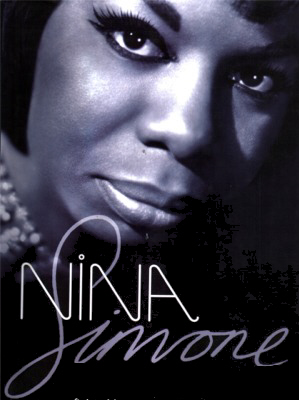Nina Simone - "Love Sorceress" |

|
Review/Preview by Jean Timmons
And Now Presenting: The Amazing Ms. Nina Simone
On December 28, 2006, the Gene Siskel Film Center is screening Nina Simone, Love Sorceress, by French director Rene Letzgus. It is a memorable film that offers a glimpse into the psyche of a performer who approached performance as art. Other than that, it is a film all jazz aficionadas (and aficionados) will relish. They get to see Simone in performance once more, playing her quasi-classical piano and singing whatever.
Nina Simone was born Eunice Kathleen Waymon in Tryon, North Carolina in 1933. According to Simone’s autobiography, the compelling and occasionally chilling I Put a Spell on You, she was just shy of her third birthday when her mother, an ordained Methodist minister, discovered her at the piano playing a beloved hymn.It was only natural for mother to take Eunice along with her as she traveled the preacher circuit to prime the congregation. At six, the child was the regular pianist at the Tryon church. In retrospect, Simone believed that “gospel taught [her] about improvisation, how to shape music in response to an audience and then how to shape the mood of an audience in response to [her] music.” One thing is certain: mother kept her busy playing piano for long hours and she never complained, at least not to her readers.
In addition to the church work, Mrs. Waymon also worked as a domestic servant and, as things would happen, her employer learned of Eunice’s talent, came to hear her, and agreed to finance piano lessons with a classical pianist. This serendipitous arrangement proved momentous in the life of the Amazing Nina Simone. She found in her teacher a person who openly praised her work, unlike her family that insisted that all things, including talents, came from God, and who introduced her to Bach.Simone writes tellingly in I Put a Spell: “Once I understood Bach’s music I never wanted to be anything other than a concert pianist. Bach made me dedicate my life to music . . .”
This passage brings greater understanding of those classically derived rifts in Simone’s music, e.g., the recording “Love Me or Leave Me.” It also illuminates the difficulty in categorizing the singer: Simone was not the type of musician who could be labeled. She certainly was not a pure jazz singer.Her repertoire was eclectic. On the 1961 At the Village Gate session, the numbers include the jazz standards “Just in Time” and “Bye Bye Blackbird,” a folk song “The House of the Rising Sun,” and a gospel “Children Go Where I Send You.” At one point, she claimed that she was probably more a folk singer than a jazz singer. But this variety could well be traced to her failure to pursue her musical interest in becoming a classical pianist. Her repertoire was fashioned from a need to support herself while she studied to become a classical pianist. And it is all over the place—protest songs, folk songs, pop songs, jazz standards. A Nina Simone album is an amusement park. Although she never became the classical pianist of her dreams, as she grew older, she became more the jazz singer than she claimed. She was a superb jazz musician, able to switch moods, sounds, pitch all together as she build a song for our delight and her own satisfaction—that’s cool.
The myth of Nina Simone is centered in her command of her performance. Love Sorceress is a remarkable film of a performance, and it looks great, too. The appearance of the colors in the print I saw last year suggested the deep reds and blacks of the technicolor process. The film was released in 1998, but it documents a l976 concert.
The film is running Thursdays, December 28 and January 4, at 8:15. The theater is located at 164 North State Street, the telephone number is 312-846-2800, the Website is www.siskelfilmcenter.org..